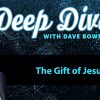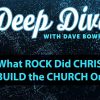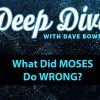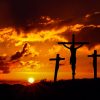Psalm 122:6 tells us to pray for the peace of Jerusalem. Despite any effort world leaders make, true peace will not come to Jerusalem until Jesus reigns. So, when we pray for the peace of Jerusalem, we are really praying for the return of Christ.
Mt. Sinai
I enjoy seeing Jesus throughout the Old Testament. In Exodus 24, when Moses went up to the top of Mt. Sinai and met with God, in those 40 days Moses was given more than the ten commandments. He was given the instructions for the Tabernacle, the priesthood, the sacrifice system, the Sabbath, and the festival days. Moses was given the how, when, and where a sinful man could come before a holy God and worship. The how was the priesthood and sacrifice system. The when was the Sabbath and festivals. The where was the Tabernacle.
The Tabernacle
All of those elements — the priesthood, the sacrifice system, the Sabbath, and the festival days — point toward Jesus, especially the Tabernacle. The Tabernacle had only one entrance. The Gospel of John verse 14:6 says, “No one comes to the Father but through Me.” The Gospel of John also has the seven “I AM” statements. In each of these “I Am” statements, Jesus proclaims His essence. Three of these are, “I Am the bread of life” (John 6:35), “I Am the light of the world” (8:12), and “I Am the gate” (10:7).
We spoke about the gate, the only entrance into the Tabernacle. We find the table of showbread and the golden lampstand inside the Tabernacle or dwelling place. Both point to Jesus — the bread of life and the light of the world.
Seeing Jesus through the Old Testament is amazing; as Exodus 9:16 says, we witness God’s power and proclaim His name throughout the earth.
Seder
We are a couple of weeks away from Passover. I have a good friend who is a Messianic rabbi and each year many churches ask him to come and lead them in a Christian Passover Seder. I enjoy these Seders because, again, these elements of the Seder look forward to and proclaim Jesus.
The Hebrew word, Seder, means “order.” The Passover meal has a specific order in which food is eaten, prayers are recited, and songs are sung. Each item on the Passover plate has a specific historical meaning related to the Jews’ exodus from Egypt. First Corinthians 5:7 identifies Jesus Christ as our Passover Lamb, so the Seder carries a New Testament meaning as well.
Shank Bone of a Lamb
In the Seder, there are several strong symbols of Christ. One is the shank bone of a lamb. Before the tenth plague fell on Egypt, God instructed the Israelites to dab their doorposts and lintels with the blood of a spotless lamb so that the Lord would “pass over” their homes and preserve the lives within (Exodus 12:1-13). This is a picture of Jesus, who was and is the “Lamb of God” (John 1:29). Passover instructions specified that the lamb’s bones could not be broken (Exodus 12:46), again foreshadowing the death of Christ (John 19:33).
Another symbol of Christ on the Seder plate is the matzoh or unleavened bread. As the Jews left Egypt, they were in great haste and, therefore, had no time to allow their bread to rise. From then on, Passover was followed by the week-long Feast of Unleavened Bread (Deuteronomy 16:3).
The Matzoh
The matzoh provides a picture of the Messiah. For example, the matzoh is placed in a bag (echad), which in Hebrew means “one.” There are three pieces of matzoh in the one. The first piece of matzoh is never touched and never seen. The second matzoh is broken in half at the beginning of the Seder; half of the broken matzoh is placed back in the echad, and the other half is placed in a linen cloth. The third matzoh in the bag is used to eat during the Seder meal. It will indwell in you.
Jews consider the three matzohs to represent Abraham, Isaac, and Jacob. But, they cannot explain why they break “Isaac” in half or why they place half of the middle matzoh back in the echad and keep the other half out, wrapped in a cloth.
The Trinity is pictured in the matzohs. The first matzoh that remains in the bag represents the Father whom no man sees. The third matzoh represents the Ruach Ha Kodesh — the Holy Spirit who dwells within us. The second matzoh, the broken one, represents Ha Ben — the Son. The reason the middle matzoh is broken is to picture the broken body of Christ (1 Corinthians 11:24).
The half put back in the echad represents Jesus’ divine nature; the other half, wrapped in a linen cloth and separated from the echad, represents Jesus’ humanity as He remained on earth. The linen cloth that wraps half of the second piece of matzoh suggests Jesus’ burial cloth. During the Seder, this linen cloth with the broken matzoh inside is hidden, and after dinner, the children present look for it. Once the Afikomen is found, it is held as a ransom until after the meal. Again, we see that these rituals point to Christ: He was fully God yet fully human. He was broken for us. He was buried, sought for, and resurrected, and His life was given a ransom for many (Mark 10:45). Jesus is the completion of the New Covenant of Jeremiah 31:31, and the Passover Seder rituals bear that out.
Also, the matzoh used for the Passover Seder must be prepared in a certain way. Of course, it must be unleavened. Leaven is often equated with sin in the Scriptures, and Jesus is sinless. Second, the matzoh must be striped — Jesus’ “stripes” (His wounds) are what heal us spiritually (Isaiah 53:5). Third, the matzoh must be pierced — Jesus was nailed to the cross (Psalm 22:16).
Bitter Herbs
The other elements of the Seder plate are traditional reminders of the Israelite enslavement of the Egyptians. They are as follows.
Parsley (karpas) is dipped in salt water and eaten. The parsley pictures the hyssop used to apply the blood of the Passover lamb to the homes of the Israelites in Egypt. In the New Testament, hyssop was used to give the Lamb of God vinegar when Jesus said He thirsted (John 19:29). The salt water represents the tears shed during the bitter years of slavery and the Red Sea that God split during the exodus.
The eating of bitter herbs (maror) is commanded in Exodus 12:8. In modern times, this is usually horseradish, one of the most bitter of herbs. The maror reminds the Jews that they were unable to offer sacrifice and worship to God, and that was more bitter than the slavery of Egypt.
Charoset (haroseth) is a mixture of apples, nuts, and spices. It represents the mortar the Israelites used to construct buildings during their slavery to the Egyptians. Of all the elements of the Seder, charoset alone is sweet and reminds us of the hope of redemption.
Hard-boiled or roasted egg (baytzah) traditionally are eaten by mourners. These are eaten during the Seder to remind participants that they are always in mourning for the loss of their temple. The fact that the egg is roasted evokes the roasting of the sacrifice on the Temple altar.
Four Cups
Four cups of wine or juice are also used at various points during the Seder. Each of these glasses has a name:
- The first glass is the “cup of sanctification.”
- The second glass is the “cup of judgment.”
- The third glass is the “cup of redemption.”
- The fourth glass is the “cup of praise.”
In the Upper Room at the Last Supper, Jesus took the first cup and promised His disciples that the next time He drank the fruit of the vine with them, they would be in the Kingdom (Luke 22:17). Later in the Seder, Jesus took the third cup — the Cup of Redemption — and used that cup as a symbol of the New Covenant in His blood (Luke 22:20). Thus, Jesus fulfilled the Passover symbolism and the whole feast, with a new meaning.
In Exodus 6:6, the Lord God promised His people that He would save them from slavery: “I am the LORD, and I will bring you out from under the yoke of the Egyptians. I will free you from being slaves to them, and I will redeem you with an outstretched arm and with mighty acts of judgment.” The phrase “with an outstretched arm” is repeated throughout the Old Testament in connection with Passover remembrances (Deuteronomy 4:34; 7:19; 9:29; 26:8; 2 Kings 17:36; Psalm 136:12; Jeremiah 32:21).
In the New Testament, the Messiah had both arms outstretched as He freed us from sin and brought us salvation.






